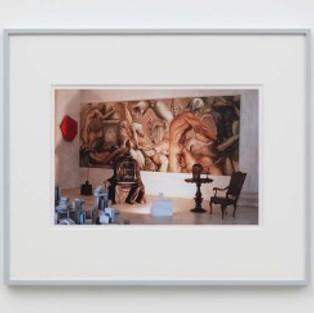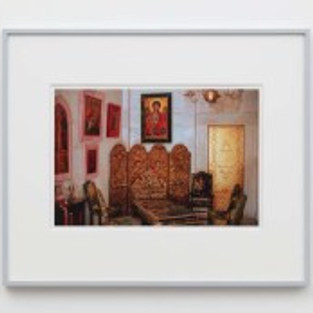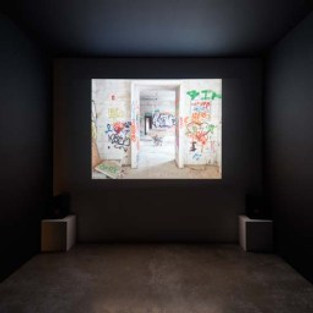William E. Jones at David Kordansky Gallery
- artandcakela
- Aug 23, 2017
- 4 min read

William E. Jones, July 15 – August 26, 2017, David Kordansky Gallery, Los Angeles, CA, Installation view. Photography: Lee Thompson. Courtesy of David Kordansky Gallery, Los Angeles, CA
William E. Jones
Fall into Ruin
David Kordansky Gallery
By Jody Zellen
Through August 26th
What makes William E. Jones’ 30 minute video, Fall into Ruin so seductive and captivating is the use of first person narrative. Via voice over, Jones relates a story about his first trip to Greece in 1982, meeting the renowned gay art dealer and curator Alexander Iolas (1907-1987) and the thrill of staying in his expansive villa. As Jones talks, still images he shot in Greece in 1982 and on a subsequent trip in 2016 appear on the screen documenting the villa in its heyday as well as its current state of disrepair.
For the exhibition a small theatre space was created in the center of the gallery. Along the perimeter of the space are twenty color photographs from 1982 documenting the artworks in Iolas’ villa. The photographs are straightforward albeit grainy snapshots of artworks in situ that clearly illustrate the idiosyncrasies in Iolas’ collecting. In one photograph, Jones captures paintings by Matta and Rene Magritte nestled in overcrowded bookshelves between art books and classical Greek vases. These uncanny juxtapositions— modern and ancient art with ornate furniture, chandeliers and tapestries— are interspersed with images of Iolas’ sexually explicit pieces.

William E. Jones “Villa Iolas (Takis),” 1982/2017 hand-coated inkjet print 20 x 16 inches (50.8 x 40.6 cm) framed: 24 x 20 x 1 1/2 inches (61 x 50.8 x 3.8 cm) Edition of 6 with 2 AP Photography: Lee Thompson Courtesy of David Kordansky Gallery, Los Angeles, CA and The Modern Institute, Glasgow, Scotland
While the photographs at first glance are interesting images of a specific place and time, when seen in context with the video they begin to resonate on a deeper level. Jones edited the travel monologue to exactly 30 minutes and its screening times are posted outside the projection space so that viewers can watch the it from beginning to end and follow its narrative construct rather than entering at mid-point. Jones relates his introduction to Alexander Iolas via a college friend and his first trip out of the United States to stay with her in Iolas’ Grecian villa. As Jones begins to speak, always with a slow and exacting cadence, images of the dilapidated villa appear on screen. These images depict the current state of property while he describes it in its regal splendor during his initial visit. There is a purposeful disconnect between what is heard and what is seen. As Jones states:
“I never directly show what I am talking about. I avoid illustration completely, even though at times I have the exact visual materials to illustrate my voice-over narration. This strategy has a couple of effects I can explain. First, it engages the spectator intellectually and creates suspense—attentive viewers ask, “Will I see Iolas’s house as the narrator saw it when young?” and at moments think, “Oh yes, I saw a picture of that earlier.” The film becomes whole only in the mind of the spectator; this is the case with every film, but I choose to emphasize the process. Second, doing this mental work creates a certain mood. You call it bittersweet or melancholy, but I think of it as engaged, a bit like the experience of a reader absorbed in a book.”
As the video progresses Jones intersperses images of present day Athens (2016) focusing upon its recent economic struggles with close-ups of sculptures from the National Archeological Museum. Here, Jones juxtaposes and reflects upon the different aspects and ideologies of ruin — linking past and present via personal memories supported by evocative snapshots that foreground Jones’ interest in queerness, the male body and global politics. It is significant that the tale involves a gay protagonist whose aura had a profound influence on the young Jones, even though they were not close friends. Jones relates being introduced by Iolas to Andy Warhol at the factory — the first factory, not the famous factory— and thinking about his limp handshake rather than his artistic production. As Jones reflects upon the significant art in Iolas’ villa and his art-world panache, it is with affection rather than benevolence. In the video, Jones laments about loss while viewers contemplate photographs of the impressive villa during Jones’ first visit. It is difficult not to reflect upon the current cultural, political and economic climate.
Fall into Ruin is nostalgically celebratory of Iolas’ contribution to the arts and his abilities to connect people across continents. As Jones describes Iolas and his trips to Greece, speaking matter of factly about how things change over time, he resurrects the grandeur while simultaneously presenting its demise.
#losangeles #california #artcollection #art #fineartphotography #artdealer #Greece #onlineartmagazine #losangelesart #contemporaryart #southerncalifornia #WilliamEJones #FallintoRuin #AlexanderIolas #JodyZellen #Gay #photography #artgallery #videoart #gallery #artandcake #DavidKordanskyGallery #losangelesartgallery #artexhibition #ArtandCakeLA #fineart #artist #story #arts #artreview #artexhibit #artmagazine #ArtandCulture #losangelesgallery #visualart #artcollector





















































































